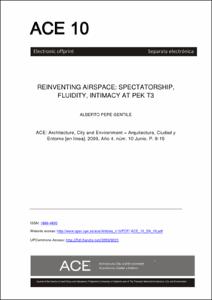Mostra el registre d'ítem simple
Reinventing airspace: spectatorship, fluidity, intimacy at pek t3
| dc.contributor.author | Gentile, Alberto Pepe |
| dc.date.accessioned | 2009-07-09T10:12:53Z |
| dc.date.available | 2009-07-09T10:12:53Z |
| dc.date.issued | 2009 |
| dc.identifier.citation | Gentile, Alberto Pepe. Reinventing airspace: spectatorship, fluidity, intimacy at pek t3. "ACE: architecture, city and environment", 2009, vol. 4, núm. 10, p. 9-19. |
| dc.identifier.issn | 1886-4805 |
| dc.identifier.uri | http://hdl.handle.net/2099/8025 |
| dc.description.abstract | In this article, I explore the contemporary practice of air travel conceptualizing airports as socio-technical mobilities. Drawing both from the notion of “space” posited by Michel de Certeau and that of “non-place” by Marc Augé, I argue that the supermodern nature of air travel has generated forms of crisis that have embedded themselves in the architecture and the modus operandi of contemporary airports. Airports are necessarily located in a physical and tangible sense, yet their function is so tightly coupled with transience, mobility and spectatorship, that they bring anthropological accounts of “place” to unprecedented extremes. In this article, I analyze three tensions that are inherently bound to the contemporary practice of air travel and that present themselves as symbiotic phenomena: spectatorship/solitude, fluidity/control, intimacy/sameness. I explore the presence and interplay of these tensions in the spatial (spectatorship), technological (fluidity) and physical (intimacy) arrangements of the recently completed Terminal 3 at Beijing's International Airport. |
| dc.description.abstract | En aquest article s'explica la pràctica contemporània del viatge amb avió que conceptualitza als aeroports com mobilitats tècnico-socials. Analitzant ambdues des de la noció de l'espai plantejada per Michael de Certeau i la noció de no-lloc de Marc Augé, s'argumenta que la naturalesa supermoderna del viatge aeri ha generat una crisi de forma que s'ha incorporat a l'arquitectura i el modus operandi dels aeroports contemporanis. Els aeroports tenen necessariament un sentit físic i tangible, en canvi s'acoblen fortament en lo transitori, la mobilitat i l'expectació, que porten a “l'espai” a consideracions antropològiques extremes sense precedents. En aquest article s'analitzen tres tensions inherents a la pràctica contemporània del viatge aeri, que el presenten com un fenomen simbiòtic: expectació/aïllament, fluïdesa/control, intimitat/comunalista. S'explora la presència i la interacció d'aquestes tensions en la planificació de l'espai (expectació), tecnològica (fluïdesa) i física (intimitat) del recentment acabat edifici Terminal 3 de l'Aeroport Internacional de Beijing. |
| dc.description.abstract | En este artículo, se explora la práctica contemporánea del viaje en avión que conceptualiza a los aeropuertos como movilidades técnico-sociales. Analizando ambos desde la noción de “espacio” planteada por Michel de Certeau, y la noción de “no-lugar” de Marc Augé, se argumenta que la naturaleza supermoderna del viaje aéreo ha generado una crisis de forma que se ha incorporado en la arquitectura y el modus operandi de los aeropuertos contemporáneos. Los aeropuertos necesariamente tienen un sentido físico y tangible, sin embargo se acoplan fuertemente con lo transitorio, la movilidad y la expectación, que llevan “el espacio” a consideraciones antropológicas extremas sin precedentes. En este artículo se analizan tres tensiones inherentes a la práctica contemporánea del viaje aéreo, que lo presentan como un fenómeno simbiótico: expectación/aislamiento, fluidez/control, intimidad/comunalidad. Se explora la presencia e interacción de estas tensiones en la planificación del espacio (expectación), tecnológica (fluidez) y física (intimidad) del, recientemente terminado, edificio Terminal 3 del aeropuerto Internacional de Beijing. |
| dc.format.extent | 11 p. |
| dc.language.iso | eng |
| dc.publisher | Centre de Política del Sòl i Valoracions - Universitat Politècnica de Catalunya |
| dc.rights | Attribution-NonCommercial-NoDerivs 3.0 Spain |
| dc.rights.uri | http://creativecommons.org/licenses/by-nc-nd/3.0/es/ |
| dc.subject | Àrees temàtiques de la UPC::Arquitectura::Tipologies d'edificis |
| dc.subject.lcsh | Airports -- China -- Beijing |
| dc.subject.other | Terminal 3 |
| dc.subject.other | Beijing's International Airport |
| dc.subject.other | Airports |
| dc.subject.other | Air travel |
| dc.subject.other | Transience |
| dc.subject.other | Mobility |
| dc.subject.other | Intimacy |
| dc.subject.other | Spectatorship |
| dc.subject.other | Aeroports |
| dc.subject.other | Viatge aeri |
| dc.subject.other | Transitorietat |
| dc.subject.other | Mobilitat |
| dc.subject.other | Intimitat |
| dc.subject.other | Expectació |
| dc.subject.other | Aeropuertos |
| dc.subject.other | Viaje aéreo |
| dc.subject.other | Transitoriedad |
| dc.subject.other | Movilidad |
| dc.subject.other | Intimidad |
| dc.subject.other | Expectación |
| dc.title | Reinventing airspace: spectatorship, fluidity, intimacy at pek t3 |
| dc.title.alternative | Reinventant l'espai aeri: expectació, fluidesa i intimitat en el PEK T3 |
| dc.title.alternative | Reinventando el espacio aéreo: expectación, fluidez e intimidad en el PEK T3 |
| dc.type | Article |
| dc.subject.lemac | Aeroports -- Xina -- Pequín |
| dc.subject.lemac | Foster, Norman, 1935- |
| dc.identifier.doi | 10.5821/ace.v4i10.2469 |
| dc.description.peerreviewed | Peer Reviewed |
| dc.rights.access | Open Access |
| local.citation.author | Gentile, Alberto Pepe |
| local.citation.publicationName | ACE: architecture, city and environment |
| local.citation.volume | 4 |
| local.citation.number | 10 |
| local.citation.startingPage | 9 |
| local.citation.endingPage | 19 |
| local.personalitzacitacio | true |


